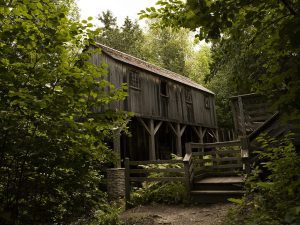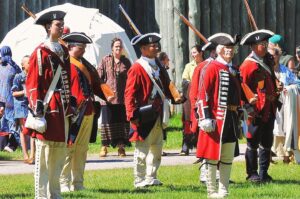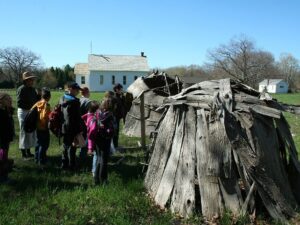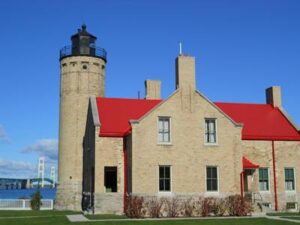Photo by the Mackinaw Area Visitors Bureau
Mackinaw City has been a pivotal location for the development of the Great Lakes for hundreds of years. That history is captured at Colonial Fort Michilimackinac in Mackinaw City.
Fur traders set up shop in the Northern Michigan’s Straits of Mackinac in the 1600’s and by the 1700’s, the area was a bustling trading center. The fort was built by the French in the early 1700’s and it was occupied from 1714-1781 by the French and the British.
Today, the reconstructed fort at Colonial Michilimackinac is a major tourist destination and historical site. Ongoing archaeological work at the Fort continues to uncover surprises and offer insight into life at the Colonial setting. Archaeologists first dug at Colonial Michilimackinac in 1959 and since then, more than one million artifacts have been uncovered.
Michilimackinac State Park was established in 1909 and has 37 acres and 2,100 feet of shoreline on Lakes Huron and Michigan. Thirteen authentically reconstructed buildings allow visitors to see what life was like in Colonial times aided by interactive displays and reenactments by costumed interpreters. Colonial Michilimackinac is a great place for children: special activities and programs take place daily during the summer season. Largely popular is the annual Historical Reenactment Pageant held each Memorial Day weekend. This event provides a reenactment of the 1763 Native American attack on the British held fort.
Colonial Michilimackinac is a real gem: when visiting Northern Michigan, a visit to this fort is a must.
Colonial Michilimackinac- Beneath the Mackinac Bridge
Mackinaw City, MI, 49701
(231) 436-4100

The Headlands, just west of Mackinaw City, is one of six International Dark Sky Parks in the U.S. and one of nine in the world.

Historic Mill Creek has 625 acres along Lake Huron, 3.5 miles of hiking trails, a reconstructed saw mill, mill dam, and more.

While it may be the gateway to Mackinac Island, Mackinaw City offers it’s own set of awesome festivals and events.

Built during World War II to haul heavy materials during the winter, the Icebreaker Mackinaw was in service for 62 years then became a museum.

Mackinaw City’s Heritage Village lets visitors explore life in the Straits of Mackinac as it was during the era of 1880-1917.

With Lake Michigan on one side and Lake Huron on the other side, Mackinaw City is a true Great Lake’s spot with lots of things to do!